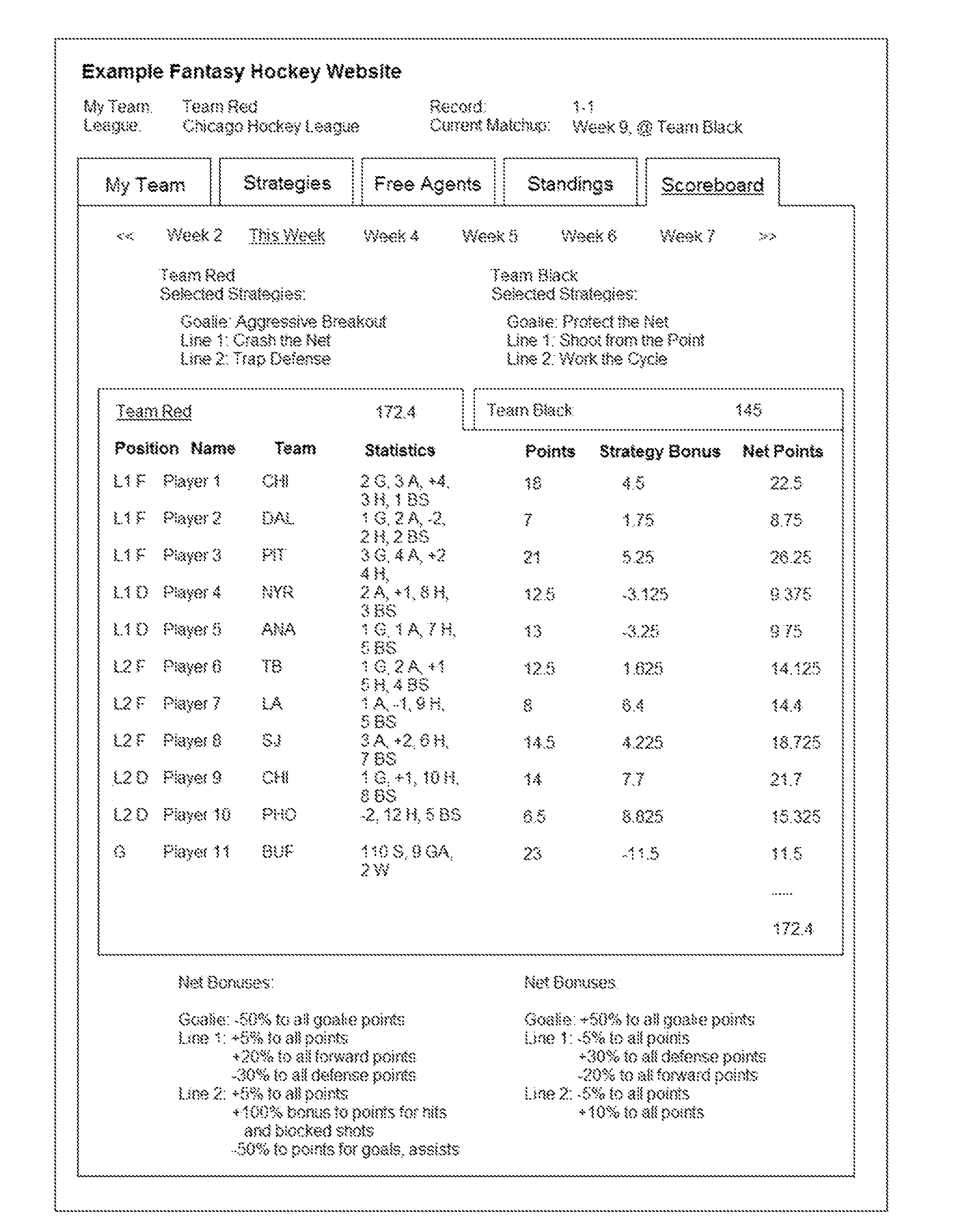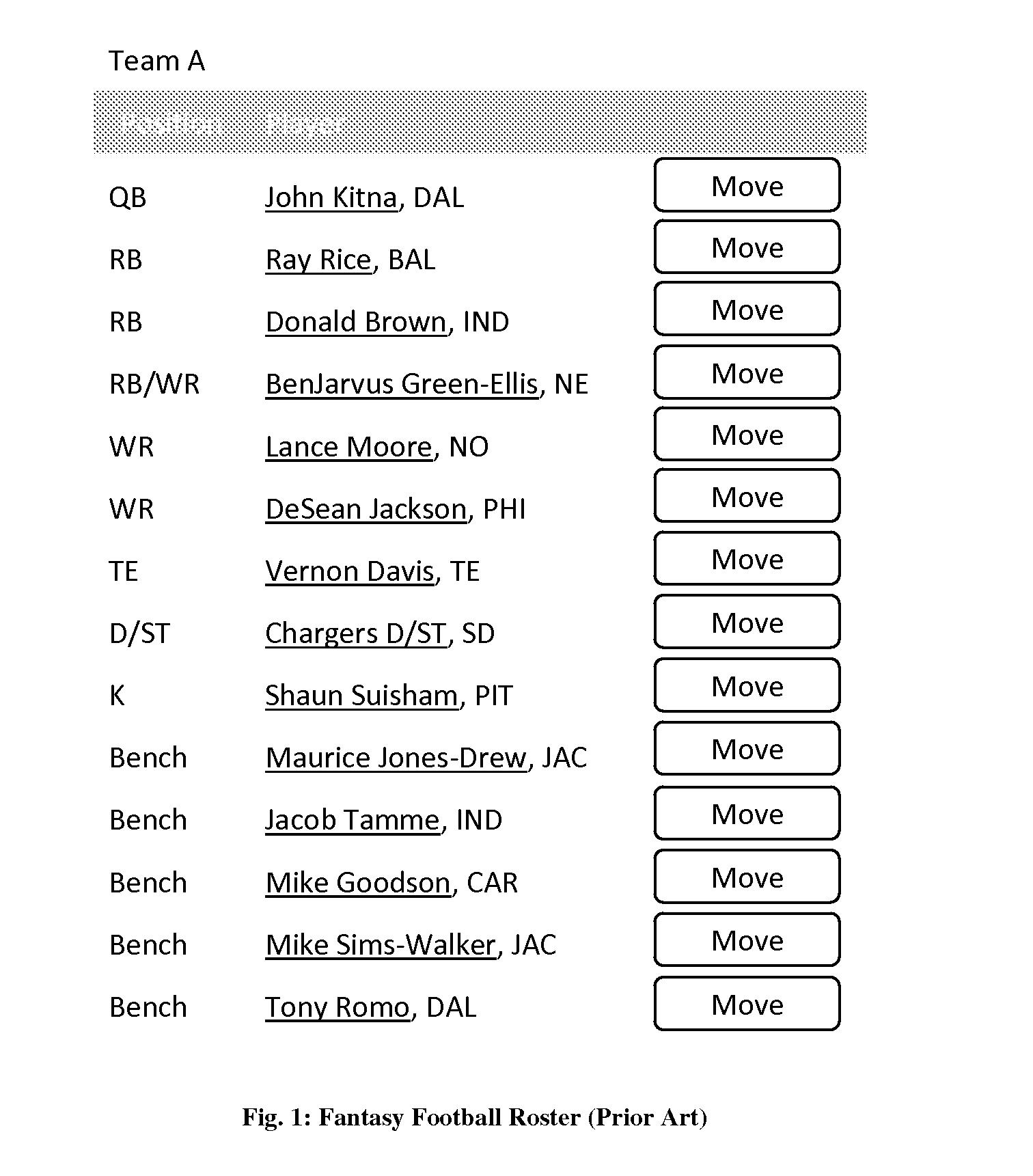Coaching Strategies in Fantasy Sports
a coaching strategy and fantasy sports technology, applied in the field of coaching strategies in fantasy sports, can solve the problems of limiting the ability of other players to score, affecting (giving a penalty to) other players, and costing the team three outs (an entire innings of outs)
- Summary
- Abstract
- Description
- Claims
- Application Information
AI Technical Summary
Benefits of technology
Problems solved by technology
Method used
Image
Examples
example 1
Only Basic Strategies
[0058]Basic strategies are the least complex and would be best for a more casual fantasy league. At the beginning of the scoring period, a fantasy owner will take a look at his team and will determine which of his players have the greatest probability of gaining the most points for his team. The fantasy owner will then select a strategy from strategies such as those listed below that will likely give his team the largest advantage. This example shows a setup where only one strategy must be selected from a single strategy group.[0059]Spread Formation I (passing strategy)—gives 20% bonus to points scored by quarterbacks and wide receivers on the owner's team[0060]Split Back Formation I (running strategy)—gives 30% bonus to points scored by running backs on the owner's team[0061]I-Formation I (balanced strategy)—gives 10% bonus to points scored by quarterbacks, wide receivers, and running backs on the owner's team[0062]Star Player I—gives 50% bonus to points scored...
example 2
Intermediate Strategies and Below
[0064]With intermediate-level strategies, the fantasy owner must now not only predict which of his players have the greatest chance of scoring, the fantasy owner must also now consider the corresponding drawbacks of a particular strategy. For example, because the Spread Formation II coaching strategy (see below) focuses on quarterbacks and wide receivers, running backs are ignored and thus given a penalty. The fantasy owner would choose the Spread Formation II strategy when the owner has a very strong quarterback and mediocre running backs. Similar to Example 1, this example also shows a setup where only one strategy must be selected from a single strategy group. Note that not all strategies in this example are intermediate level strategies; I-Formation I and Extra Man I are basic strategies and do not have any penalty. For the purpose of balancing strategies to be fair for all players, combinations of strategies from different levels may be necessar...
example 3
Advanced Strategies and Below
[0070]Advanced strategies give the fantasy owner the ability to affect the opponent's team. FIG. 9 shows a fantasy owner selecting both a strategy and a counter strategy. This mimics the ability of a real-life coach to anticipate and react to an opposing team's strengths and weaknesses. Two strategy groups are used in this example—strategies and counter strategies. The fantasy owner may select one strategy from each group. Note that multiple strategy groups may be used for any level of strategies and is not restricted to being used for advanced strategies and above.[0071]Strategies (affects owner's team)[0072]Spread Formation II (passing strategy)—gives 20% bonus to points scored by quarterbacks and wide receivers, but 30% penalty to running backs on the owner's team[0073]Split Back Formation II (running strategy)—gives 30% bonus to running backs, but 20% penalty to quarterbacks and wide receivers on the owner's team[0074]I-Formation I (balanced strategy...
PUM
 Login to View More
Login to View More Abstract
Description
Claims
Application Information
 Login to View More
Login to View More - R&D
- Intellectual Property
- Life Sciences
- Materials
- Tech Scout
- Unparalleled Data Quality
- Higher Quality Content
- 60% Fewer Hallucinations
Browse by: Latest US Patents, China's latest patents, Technical Efficacy Thesaurus, Application Domain, Technology Topic, Popular Technical Reports.
© 2025 PatSnap. All rights reserved.Legal|Privacy policy|Modern Slavery Act Transparency Statement|Sitemap|About US| Contact US: help@patsnap.com



